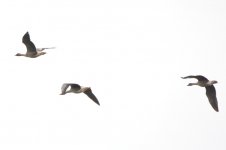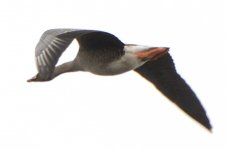Stonefaction
Dundee Birding....(target 150 in 2024).

Caught these 3 geese just after they passed overhead at Montrose Basin today. Although there were rather a lot of Greylags and Canada Geese in the basin, these 3 rather surprisingly appeared to be a pair of Pink Footed Geese and a (possibly Taiga) Bean Goose.
Although it is probably still a bit early for returning winter birds, there are always a few usually injured Pinkies stay for the summer, and there has been a Bean Goose around in the Angus area in previous years.
Any comments on the middle bird of the 3? The beak certainly looks too small and the wrong shape for Greylag (sometimes a few around with orange legs), and the underwing certainly appears to be all dark.
Although it is probably still a bit early for returning winter birds, there are always a few usually injured Pinkies stay for the summer, and there has been a Bean Goose around in the Angus area in previous years.
Any comments on the middle bird of the 3? The beak certainly looks too small and the wrong shape for Greylag (sometimes a few around with orange legs), and the underwing certainly appears to be all dark.





